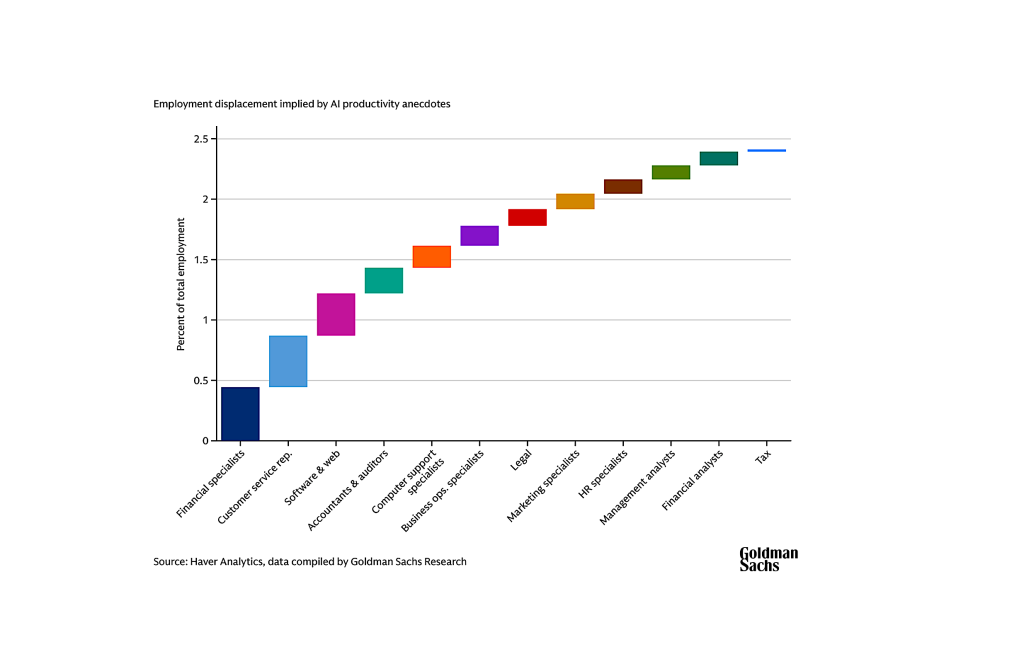
A new study by Goldman Sachs – which appears to contradict their earlier views – states that as of today around 1.7% of legal jobs are ‘at risk’ due to AI-driven automation. Two years ago the investment bank suggested up to 44% of lawyer roles could be automated. That’s quite a change!
However, we should not get too excited about AI’s impact – or rather its lack of impact – on jobs. More immediate data does indeed show that genAI is reducing hiring in several areas, in particular for junior computer programming jobs. Graphic designers and telephone call centre workers have also been hit, the bank stated after examining official US employment data.
Yet, alongside lawyers – see table below – others in professional roles generally see only between 2.5% and 0.5% of their roles under immediate threat of automation by AI, with tax advisers most exposed and finance experts the least. But, even so, the max level of impact – for now – is 2.5%.

Moreover, as the global economy grows and new needs are created, such losses may well be quickly filled in and even surpassed by higher employment demands, at least in professional services.
What Does This Mean?
Well, it seems to suggest that roles that rely on high levels of accurate human judgment, e.g. legal advice, remain largely immune to AI job losses…for now. Meanwhile, those who do tasks that can be completely handled by AI are at real risk and that will impact the jobs market until the economy evolves beyond this challenge.
I.e. the job risk element here is based on whether the totality of one’s role can be automated. If there is a little bit left over, which especially is all about human judgment, then it’s hard to remove that role, even if that professional is using a lot of AI.
If you are 99.999% confident that the code a junior engineer would normally handle can be replaced by genAI-made code, then that role is cooked. There is no moat for that role.
But, if you think legal AI tools are only 90% as good as a lawyer’s work, then that lawyer is fine. This is because the ‘last mile’ of capability, in terms of accuracy, completeness of the review, the subtle legal understanding of the issues and more, to get you to 99.999% is incredibly hard to do. So, unless the employer wants to take on a huge risk, then they will have to keep using those junior lawyers….for now.
Hence the number of lawyers who are replaceable today with AI is only around 1.7% – and they’re the ones who are doing such low-level work that they really can be replaced – presumably because they’re providing very little professional input or judgment.
Is this a big deal either way?
Well, if the US lost 1.7% of all its lawyers that would still be about 22,000 jobs….at least until Jevon’s Paradox kicks in and expands the market, leading to those people getting new jobs in the legal sector.
What about long-term? It’s way harder to say. And much depends upon accuracy. If accuracy and completeness of answers gets to 99% for vast swathes of legal work, then everything changes. But, we are not there yet.
So, good news for now, but let’s not assume AI accuracy levels will stay as they are. Legal AI tools will keep improving.
You can find the Goldman Sachs report here.
—
Legal Innovators Conferences in New York and London – Both In November ’25 – Inhouse Day and Law Firm Day at each conference.
If you’d like to stay ahead of the legal AI curve….then come along to Legal Innovators New York, Nov 19 + 20, where the brightest minds will be sharing their insights on where we are now and where we are heading.

And also, Legal Innovators UK – Nov 4 + 5 + 6

Both events, as always, are organised by the awesome Cosmonauts team!
Please get in contact with them if you’d like to take part.
Discover more from Artificial Lawyer
Subscribe to get the latest posts sent to your email.

